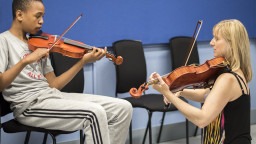M2 – The music leader has a clear intention and has planned the session accordingly, whilst still retaining room for flexibility.

I deliver sessions with children aged 0-5. Some may be with families in Children’s Centres, others might be in Reception classes. I will adapt my planning, depending on what the setting staff require. However, the children’s learning is always at the heart of my planning and thinking. If I’m choosing a song to sing with the children, the first consideration will be: what do I want the children to gain from this? What is the learning objective? What song will enable us to fulfil this objective?
For example, if the learning objective was “to be able to match movement to a song”, I would choose a song with a steady pulse. Then, in the session, I would be looking to see whether the children are able to match their movement to the music by the end of the activity. It is really important that you are flexible in the session and respond to these observations. If certain children are struggling, I may adapt the activity so that ones who can match a movement to the pulse can support those who not yet able to do so. This may be done very subtly…perhaps by encouraging one child to hold a hoop with another and move the hoop up and down in time to the pulse. As part of this process, you need to be open-minded to what you’re seeing and also open to communication with the setting staff, who may have more insight into how and why the children are responding to the activity. On other occasions, my planning may be less formal, with sessions that focus on letting the children lead the learning. However even sessions like this that are “planned in the moment” require careful consideration and preparation. Before attending settings, I will think about the provocations that I will create to stimulate the children’s learning. For me, a provocation could be a big gathering drum in the centre of the room.
Before setting this up, I need to consider what music skills I am looking to see from the children: am I looking to see if their movement matches a pulse? Am I looking to see if children are spontaneously singing? What are they singing? Is it a small repetitive two note pattern? Is it a pot-pourri or a mash-up of a collection of songs from their world? It is important to know what learning looks like ahead of the session so that I can respond appropriately to the children. With both approaches, the process of reflective flexible practice is vital so we can think about how our actions engage all those involved in a process of continuous learning.
Taken from Take Art
